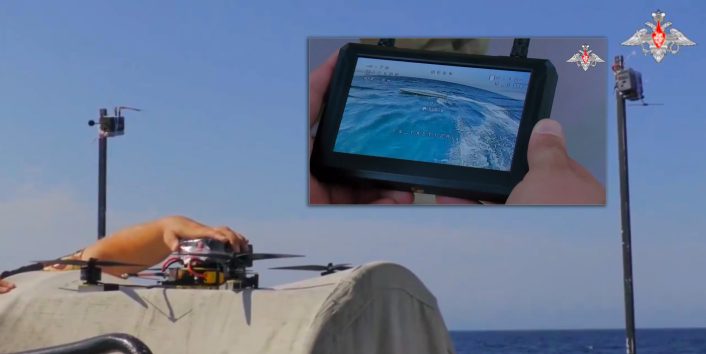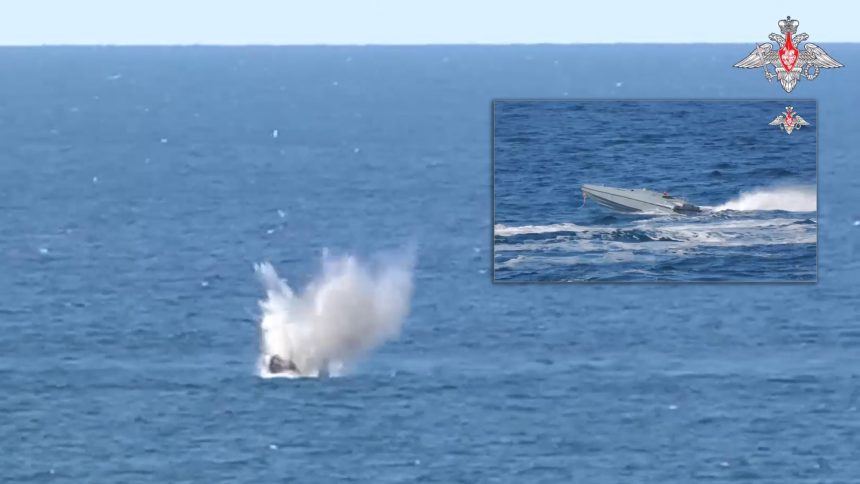The FPV drone flown from the patrol vessel makes it ‘harder for operators to pilot’ the UAV while the USVs ‘change course and speed.’ FPV drone operators thus “require practical skills.”
The RuMoD (Russian Ministry of Defense) has shown a FPV (First Person View) kamikaze drone being launched from an Black Sea Fleet (BSF) vessel during training and hitting a vehicle closely resembling the Ukrainian Magura USV (Unmanned Surface Vessel). It is possible that the USV in the video is a replica of the original one to be used to get FPV operators accustomed to the visual representation of the vessel they will face in combat, although the RuMOD defined it a “Ukrainian-made trophy Magura”.
Russia previously captured an almost intact Magura, however it is unlikely they decided to use for target practice an asset with a high intelligence value. There are unconfirmed reports about Russia possibly trying to reverse engineer the USV, after the captured one was disassembled and the photos of the components were released online.
Russia has used FPV UAVs prior to this in April and May, although these appear to have been launched from land, and showed the footage from the drone’s front camera and other overhead drones. This is possibly for the first time an official footage from the RuMoD features the UAVs on its BSF ships. The small drones might therefore soon replace its larger on board weapons to destroy incoming boats.
Few days earlier, a report on TASS mentioned the BSF has fielded the new “Krechet” thermal imagers on its naval helicopters for engaging Ukrainian USVs, presumably for attacks in low daylight and dark conditions. The thermal imagers are installed on the door machine guns of the Russian Navy’s Ka-27 helicopters that have been used to engage Ukrainian USVs.
The Black Sea Fleet is conducting exercises to use FPV drones against enemy naval drones. This is the right direction. pic.twitter.com/J4uQ2EYbVz
— Russia Truth (autonomous pro-Kremlin infowarrior) (@Russia_Truth) October 16, 2024
The helicopter has been equipped with both 12.7 mm machine gun pods installed on the stub wings and door guns, usually the 7.62 mm PKM. While the report does not specify which gun will be used with the Krechet system, earlier images that appeared in June showed the system used with both 12.7 mm and 7.62 mm machine guns.
Video
So far, Russia has used smaller naval assets to destroy Ukrainian USVs. Two of these include the Project 22160 patrol vessel and the heavily armed Project 22800 corvettes, equipped with the Pantsir-M gun/missile hybrid CIWS (Close-In Weapons System), the navalized variant of the standard Pantsir, to combat Ukrainian USVs. Late in May 2024, a Project 22800 vessel was reported to have sunk following a strike by an ATACMS (Army Tactical Missile System). Other assets used to counter USVs include Su-30 and MiG-29 fighters performing strafing runs.
The RuMoD video shows crewmembers on the deck of an unspecified patrol vessel “training to neutralize uncrewed surface vessels.” The patrol vessel makes it “harder for operators to pilot FPV drones and search for naval targets,” the accompanying RuMoD statement said, possibly referring to the fact the ship is moving and the sea making it an unstable platform.
“When returning drones after locating targets, it is necessary to calculate both the direction and speed of patrol vessels and air currents,” added the statement. It also recognized USV tactics as “active maneuvers” that “change course and speed, making it as difficult as possible for FPV drone operators to find and approach” them. FPV drone operators thus “require practical skills.”
The statement then identified the target used during the training as the “Ukrainian-made trophy Magura uncrewed surface vehicle.” While the USV seen in the video is highly similar to the one captured earlier this year, there are some differences.
The video shows the crewmembers assembling the quadcopter UAVs from kits. The Magura is meanwhile making tight, zig-zag turns in the water, when the operator (wearing a First Person View visor) flies the drone into the boat, as seen in a capture of the control console. The USV almost breaks in half, as shown in the off-camera capture of the hit, however no explosion other than the one of the FPV.
This means the Russians may have removed the explosive charge from the USV, if that was really a captured example, or it was missing altogether, if that was a replica used as target. Needless to say, Russian engineers have thoroughly examined the technology inside the boat.

Magura Kamikaze USV
As for the Magura itself, a unit was photographed having washed ashore around Crimea’s Sevastopol naval base of the BSF in Nov. 2023. MAGURA, which stands for Maritime Autonomous Guard Unmanned Robotic Apparatus, is described as a “next-generation, multipurpose, USV developed by STE (SpetsTechnoExport).”
Of the three distinctive flat dishes on the top, one could be a Starlink terminal, since Ukraine has installed these on its previous kamikaze boats and they also closely resemble the Starlink receivers seen elsewhere. This, however, cannot be said with certainty as, in Aug. 2023, SpaceX chief Elon Musk was accused of cutting off Starlink services to Ukrainian drones, opposing its military usage.
The thin, elongated, V-shaped hydrodynamic hull has an integrated electro-optical device, carrying 320-kilogram explosives, and has a water-jet type propulsion, instead of rotary boat propellers. The unit captured by the Russians appears to be an earlier design, which later evolved.
A model of the newer MAGURA V5 was displayed at the DSEI 2023 held in September of that year in the U.K. Some reports claim it has a speed of 42 knots and a range of 833 km.
https://t.co/xIa6rOGtqh
The LPK-101 “Krechet” sight with a thermal imager for the PK (7.62mm) machine gun, designed to combat Ukrainian UAVs and unmanned boats (BEC).
Previously, a similar set up was shown for 12.7 mm machine guns and was demonstrated installed on a Kord machine… pic.twitter.com/SHja8ssKEO
— Tony (@Cyberspec1) June 23, 2024
The system is essentially an electronic riflescope linked to a display which is installed on a mount beside the gun’s magazine. Prior to that, a video showed a soldier firing the PKM, possibly on a training target that appears like a small rock outgrowth in the sea, by tracking the thermal mode feen on the external screen. The setup allows a wide field of view without having to aim downrange from the scope or the iron sights, enabling better target acquisition, and simultaneously engaging multiple hostile USVs, added the report.









